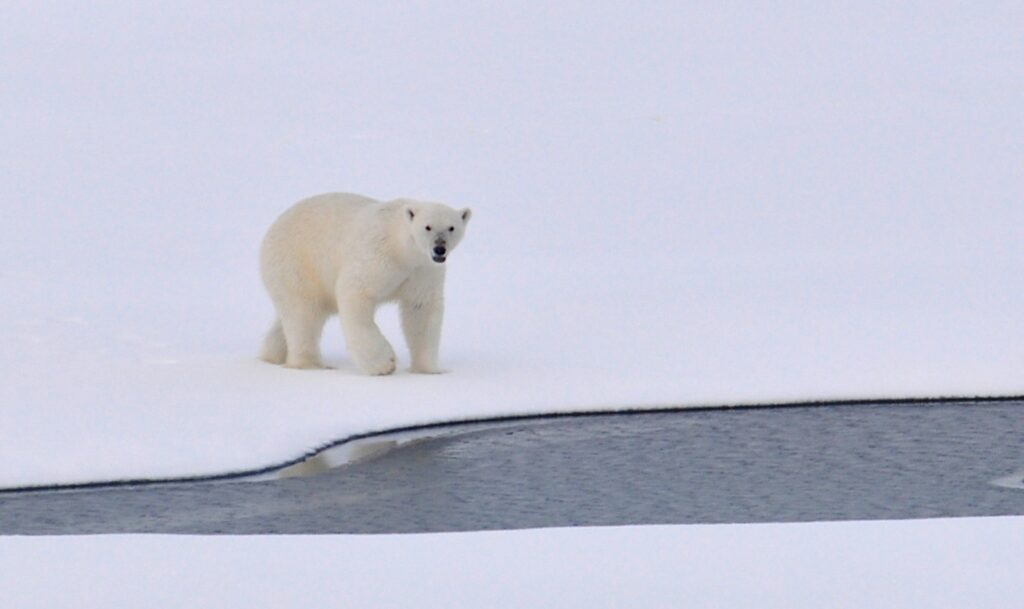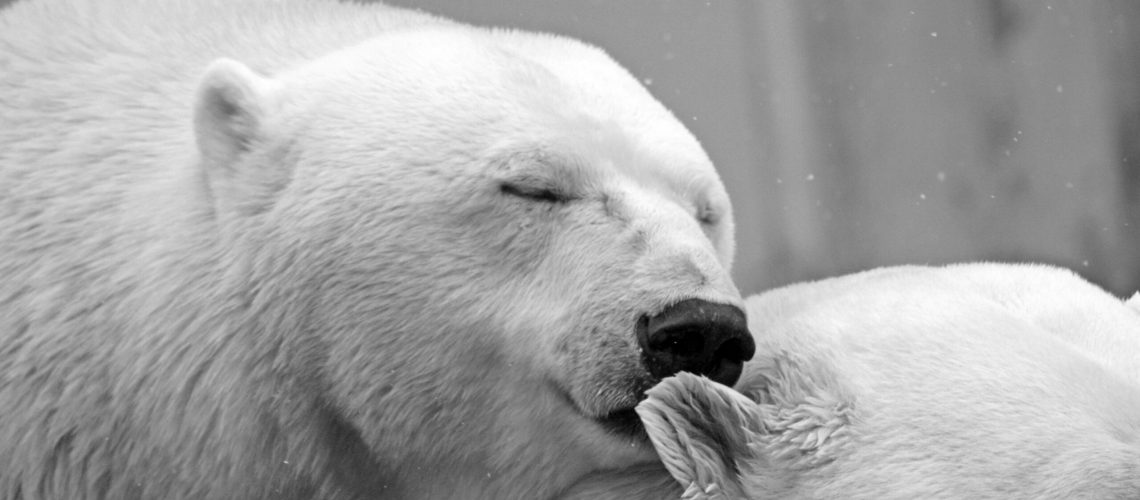Guest Post by Annie Kellner, 2021-2022 Sustainability Leadership Fellow, and Ph.D. Candidate in the Department of Fish, Wildlife and Conservation Biology and the Graduate Degree Program in Ecology at Colorado State University
Polar bears have become the global bellwether of climate change: a symbol for an impending catastrophe that will forever change the natural world as we know it. Polar bears were the first species to be listed under the Endangered Species Act proactively. That is, they were listed based on the preponderance of evidence supporting climate change and its effect on their sea ice habitat, and not because their numbers at the time of the 2008 listing were dire1. However, many of us have tied our perception of where we are on the climate change trajectory – or whether there is even a trajectory at all – to the status of the polar bear.
Arts and Sciences
We all felt our hearts leap when we saw photographer Paul Nicklen’s video of an emaciated polar bear dragging its hind legs across an iceless landscape. Reactions to this work, and its amplification by National Geographic, ran the gamut but a common feeling was anger. Anger, either, at the world for doing next to nothing about climate change, or anger at the photographers and media for subjecting audiences to what they saw as disturbing, agenda-driven content. After all, no one can prove that those particular bears are casualties of climate change. Animals die in the wild all the time – of old age, of illness, and often, of starvation that has nothing to do with climate change. While wrath directed at the photographers is misplaced – it is the job of an artist to make art – as a polar bear researcher, I grit my teeth when content like this goes viral. Not because scientific accuracy matters in this context, but because it doesn’t. These pieces are poignant metaphors and beautiful, tragic, heart-wrenching works of art; they are not science. When people wield videos like these as climate change proof of concept – or, by the same token, seize upon the obvious and irrelevant cause-and-effect fallacy – it mistakes art for science, undermines both, and compromises honest, nuanced discourse around a critically important topic.
The science of polar bear demographics, like climate science, is complicated. Are the polar bears in trouble? Certainly. But their extinction is not imminent, nor will their decline be linear. No scientific studies have yet projected global extinction of polar bears. We can’t predict that far into the future with reasonable certainty, the same way each of us can be pretty sure what the state of our own health will be at the end of today, but as we project out into months, years, and decades, the picture becomes less clear. For polar bears, the most recent modeling effort2 shows the extirpation of all subpopulations outside the Canadian Archipelago by the year 2100 under a high emissions scenario. What that means is while the species may not be extinct by 2100, there will be but a few small groups of bears in a presently ice-locked group of islands in the High Arctic.
A Glimmer of Hope for the Polar Bear
It may seem counterintuitive that there are parts of the Arctic with too much ice for polar bears, but the Canadian Archipelago is currently one of them. Thick, year-round ice is poor habitat for polar bears because even in the height of summer they can’t break through to the seals. For hunting, polar bears prefer ice the way it is in early spring, when the sun melts it just enough to thin it out and form leads – networks of long, river-like cracks – where the bears can amble along the edges and wait for seals to surface.

As we move further up the global temperature curve, thick, year-round ice will become winter-only ice, and when it thins and breaks apart, polar bears will move into those areas. The Canadian Archipelago holds some of the most impenetrable ice in the Arctic, with historical wintertime depth ranging from 10-26 feet3. That is why a glimmer of hope for the species resides among those islands. If we can turn this gas-guzzling ship around before that region completely liquefies in summer, polar bears may be able to seek refuge, and from there, repopulate the Arctic if and when cooler conditions return.
That’s the theoretical best-case scenario, anyway, keeping in mind the decades-long lag time between mitigative actions on greenhouse gas emissions and their realized effects. Not to mention that beyond the relatively simple relationship between polar bears and sea ice, there are also seals and the rest of the intricately intertwined Arctic ecosystem to contend with. Climate change will alter ocean currents, jet streams, species distributions, and the human geopolitical landscape. Those complexities aside, this small cause for hope is rooted in the same phenomenon responsible for differences between polar bear responses to climate change we see today. In southerly areas where the ice already melts in summer, and is now ice-free longer, we are seeing cubs and young adults lost to starvation4; in some northern areas, warmer waters have ushered in a bounty of newfound resources to previously ice-locked places.
The Truth
F. Scott Fitzgerald famously wrote, “the test of a first-rate intelligence is the ability to hold two opposing ideas in mind at the same time.” In the parlance of science, we say there is ‘uncertainty’ in the near-term regarding the effects of climate change on polar bears at any given scale. ‘Uncertainty’ does not mean we have no idea what to expect; it means there is a range of possibilities, and some are more likely than others. It also entails that each prediction is only valid for a particular place in time and space. As the near-term segues into the long-term, the range of possibilities for polar bears will be reassessed and, likely, reduced. Ultimately, there is no evidence at present supporting the species’ persistence in an ice-free Arctic. Fitzgerald continues, “One should, for example, be able to see that things are hopeless, yet be determined to make them otherwise”.
Perhaps complexity is an inevitable casualty of our fast-paced, 140-character culture, but clearly, there are people who benefit from reducing complicated topics to black-and-white, divisive rhetoric. For a self-interested contrarian with scientific credentials, one can easily become a darling of right-wing media by cherry-picking convenient data and fanning the flames of conspiracy in the name of truth.
Truth, though, is often in the nuance. In science, it is in the distributions, the ranges, and the confidence intervals. In art, it is everywhere. Art is under no obligation to define its parameter space or limit its inference. Art is, then, a perfect companion to science: it can begin where science leaves off, explore its implications unabashedly, and transcend the barrier between empirical and emotional truth. However, we all bear the responsibility to tell one from the other, especially in the media. We can work to restore nuance to our discourse that does not demand demure art and simplistic science. In the case of the polar bear, simplistic interpretations lead to premature despair on one extreme and false hope on the other. The truth, and the real hope, lies in the nuance in-between.
Sources
1 United States Fish and Wildlife Service. (2008). Endangered and Threatened Wildlife and Plants; Determination of Threatened Status for the Polar Bear (Ursus Maritimus) Throughout Its Range. Federal Register 73(95), 29211-28302.
2 Molnár, P. K., Bitz, C. M., Holland, M. M., Kay, J. E., Penk, S. R., & Amstrup, S. C. (2020). Fasting season length sets temporal limits for global polar bear persistence. Nature Climate Change, 10(8), 732-738.
3 Sou, T., & Flato, G. (2009). Sea ice in the Canadian Arctic Archipelago: Modeling the past (1950–2004) and the future (2041–60). Journal of Climate, 22(8), 2181-2198.
4 Rode KD, Amstrup SC, Regehr E V. 2010. Reduced body size and cub recruitment in polar bears associated with sea ice decline. Ecol Appl. 20(3):768–782. doi:10.1890/08-1036.1.






